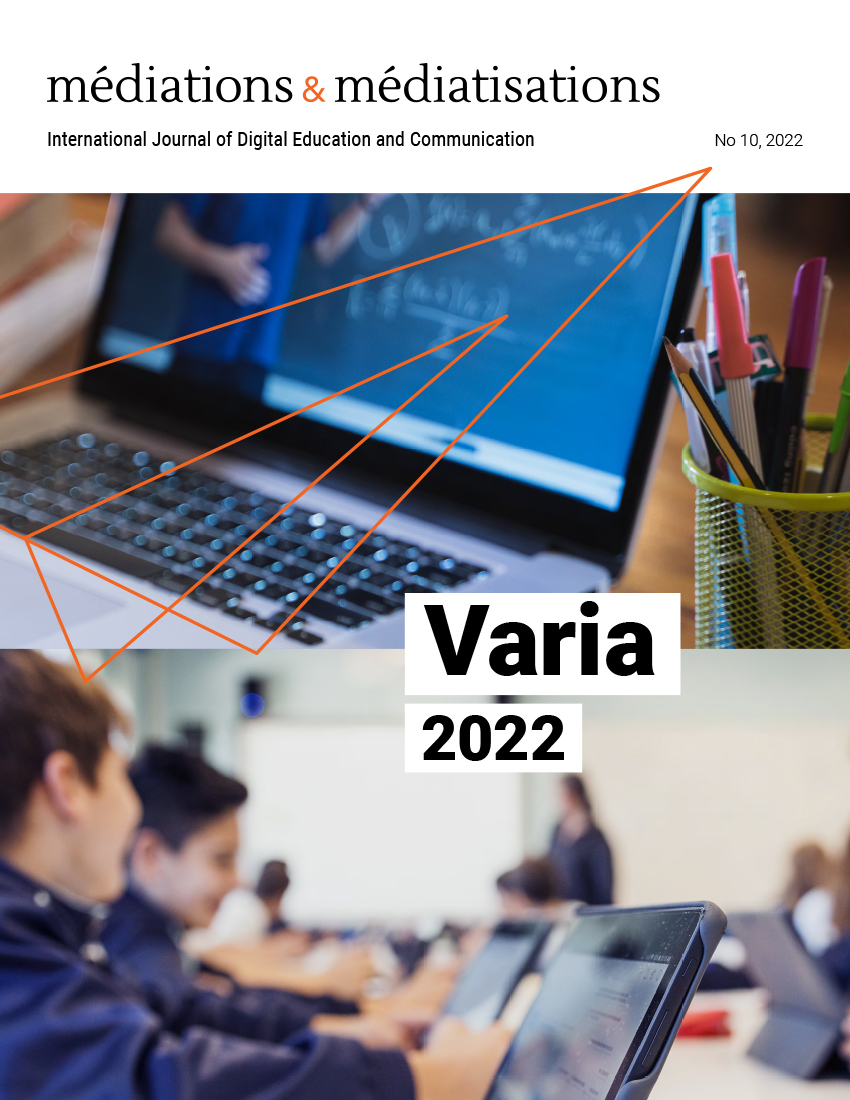No 10, December 2022
Full Issue
Summary
Editorial
Abstract
This issue (varia 2022) brings together six articles on distance education, self-regulation of learning, and cooperative or collaborative group interactions and dynamics. It includes two research articles, two practitioner articles, a discussion article and a review. The research and thoughts from both sides of the Atlantic shared in this issue can be a source of inspiration for researchers and practitioners. Indeed, these texts highlight the importance of interactions and the regulation of exchanges within collectives, whether composed of primary school students and teachers, distance learning students or researchers and practitioners gathered to carry out a project.
Research articles
Abstract
This article describes a research study carried out in the Aix-Marseille Academy, bringing together researchers from Inspé and Rep + schools from Marseille's Northern districts. Based on a call for tenders from the field, the Inspé researchers offered to support the implementation of actions to support the educational team's needs. We mainly focus on the cooperative council seen here as a tool to act on the classroom climate, and we particularly observe the teachers and students appropriation of the tool. The research question is: What are the effects of teachers and students appropriation of cooperative councils in the context of participatory research oriented towards establishing a cooperative council at the service of the school climate? Finally, we present some results on the effects onspeaking; the discovery of the other; the effects on rethinking the space, and on rule compliance.
Abstract
This article from the field of education and training sciences reports on research aimed at better understanding the mechanisms by which homo and hetero-regulated interactions influence students' self-regulation in virtual universities. A qualitative study based on a semi-directive interview guide was implemented. This resulted in ten conceptualizing categories (Paillé and Mucchielli, 2016). The analysis of these categories highlights the fact that students build their self-regulated learning through the implementation of mediations in mediated training and communication systems (Peraya, 2010), the determination of a process of genesis instrumental (Rabardel, 1995), the creation of online learning communities (Cristol, 2017) and the development of volitional strategies for controlling internal states and the learning environment (Corno, 2001).
Practitioners' articles
Abstract
To foster the adoption of computer-based learning environments in the classroom, based on both research and user tests, the French State funded via theeFRAN projects, heterogeneous consortia featuring EdTech companies, teachers, and research laboratories. While at first glance, the composition of such consortia suggests that all the skills required to reach these objectives are all present, divergences among stakeholders may have hindered the design process on various occasions. We illustrate this hypothesis using the case study: Les Savanturiers du Numérique, responsible for the design of the Student-Researcher Digital Notebook (SRDN). Differences of perspectives and conflicting interests, as well as the initial lack of rules regarding the collaboration within the consortium led to a series of consensus that ultimately hindered the utility and usability of the learning environment. Based on a longitudinal analysis of the entire design process, we offer an analysis of the design process issues associated with the multiplicity of visions expressed.
Abstract
Université TÉLUQ offers various programs in educational technology and distance education. These programs are designed to train researchers and professionals in educational engineering, educational technology, and distance education. The program team has recently adopted a program approach that provides an opportunity to revise courses while ensuring overall coherence within each of these programs. This pedagogical coherence is built around a 'competencies' referential in educational technology and distance learning, which we present as a sharing of practices in this article. The context that led to the development of such a referential and the working method to achieve it are first briefly explained. The referential with its roles, competencies, components, and sub-components of competencies is then presented, as well as a reflective review of the process.
Discussions and debates
Abstract
Online learning has been studied extensively through self-directed learning over the past decades. From the technological standpoint, researchers have long focused on how personal learning environments could help foster 'users' agency. These ecosystems of digital tools make it possible to structure their informal learning process. The approach researchers follow when they study the tools behind self-directed learning could evolve in the coming years. Firstly, we witness the apparition of online platforms explicitly designed for self-directed learning, combining functionalities previously dispersed within a palette of generic tools in one place. Secondly, e-learning standards are changing to consider the growing importance of informal learning. The gradual replacement of the SCORM standard by the xAPI standard symbolizes this paradigm shift. In this contribution, we present both the platforms' evolution and the use of learning analytics. We debate the potential implications of these new technologies on the way we conceptualize online learning.
Reading notes
Abstract
Published in 2022 in the "Formation à distance | Distance learning" collection of the Presses de l'Université du Québec, the book L'enseignement des mathématiques : une transition des cours en présentiel vers la formation à distance (Mathematics education: A transition from face-to-face to distance learning) is edited by Ghislain Samson, Khoi Mai Huy, and France Lafleur. Composed of eight chapters, it brings together the contributions of twenty researchers, mostly from Quebec and Morocco. This book review provides a summary of the book and then critiques it, highlighting its strengths and limitations.

